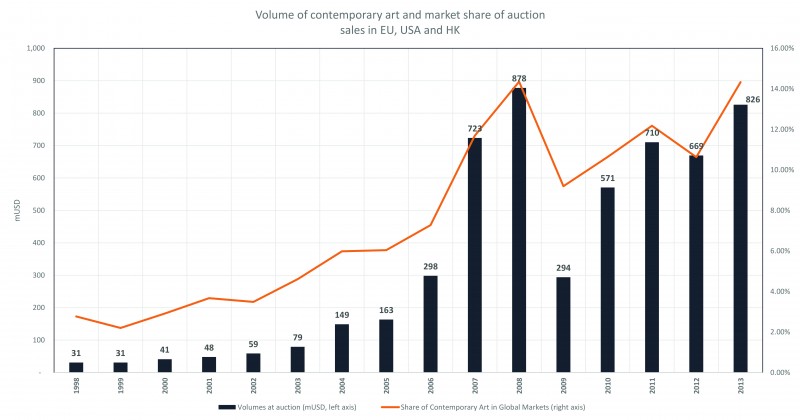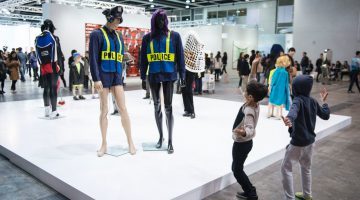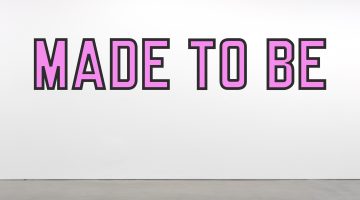By Alain Servais
Art is a language which opens your heart to the Other. (Mera Rubell)
Art as a form of experimental activity overlapping with the world. (Claire Bishop)
Art is not beauty or novelty; art is effectiveness and disruption. (Leo Ferrari)
Q: What is art for?
A: It’s a way of resisting the lack of meaning in things, a desperate attempt to make sense of how random and absurd the world is—and it’s also a way of celebrating exactly that. (Amalia Pica)
I truly love art, and I love it with a dose of curiosity, searching of the limits, and ample questioning. I have also been immersed in financial markets since my adolescence, which has developed within me innate analytical reflexes. I hear and read so much about the vicissitudes of the current evolution of the art market, but I feel the view is not large enough. I need to achieve more height and a broader contextualization in order to understand it and hope to make some useful recommendations.
There is much talk about the gallery model lately and how galleries should find a solution to their problems. I think one solution involves taking a step back and creation collaboration between galleries and stakeholders. Galleries cannot find solutions to their problems alone—cooperation is a necessity.
The Art Market: An Evolution Toward Industrialization
So what kind of world are we stepping into? It’s a world that many industries have known for a long time. Think about the watch industry in Switzerland. Who would have thought that in the 1980s the Swiss watch industry would be on its knees, close to totally disappearing, killed by the Japanese watch industry? Obsolescence and a need for deep restructuring is a natural cycle of evolution that the art industry has not yet lived through.
The art market was, until recently, a small industry with comparatively little money involved, living under the radar of “financialization.” Things have changed dramatically in a short amount of time. To illustrate this, we only need to look at the evolution of the auction of artworks in the European Union, the United States, and Hong Kong created by artists born after 1950, which I assume as a definition of contemporary art. Investigating sales data of such artworks, I could not believe that as recently as 2000 the total was $41 million—an amount you would find in a single evening’s sale at Phillips Auction House today. This figure is now in the region of $850 million, or a factor of almost $21 million in 14 years. There is no reason to doubt that the increase in turnover is of the same proportion in galleries.
Suddenly, the buying and selling of art is not a hobby anymore, but exists on the kind of money that brings professionalization and greed. Let us try first to understand what the source of this wall of money is in order to assess its durability.
This cycle started in the Reagan era at the end of the 1970s. Reagan diagnosed that the U.S. economy was almost dead; he surmised that no innovation and no development had come out of the previous crisis. So he said, “Okay, among other radical reforms, I’m going to slash capital gains tax from 39% to 20%.” In doing so, he showed that the deficit could become smaller. It seems technical and simplistic, but it started a ball rolling that increased the income share of the top 1%, as a competition to the bottom rung of the tax bracket continued over the years.
However, this is not only about taxes, but also about capitalist risk-takers seeking to take advantage of big opportunities, just as China has offered. China entered the international capitalist field not because they’re generous to foreigners, but because they observed that they had 20 million peasants moving to the cities every year, and if they didn’t find them all jobs, after 10 years there would be 200 million unemployed in the cities and the communist system would collapse. So they opened special economic zones for international trade and Western capitalists rushed in. The Chinese government was very satisfied because profit was not their primary concern—they were focused on employing their countrymen and women. In 1991, the Iron Curtain fell and the world market grew as global access opened to billions more workers and consumers. This shift caused a massive transfer of well paid and stable manufacturing jobs from the West to the developing world and a rise in low-income service jobs. With advances in technology and the continued use of petroleum, raw materials usage increased dramatically, spreading wealth to resource-rich countries like Brazil and the nations within Central Asia and the Middle East. The result is what we have today: the wealthiest 1% of the global population now controls above 20% of the income.

In October, 2014, Christie’s sold $853 million of postwar and contemporary art, headed by two Andy Warhol works. Courtesy of Reuters. Photo by Brendan McDermid.
The Consequences of Amassed Wealth
Absolutely all assets—art at the top of the list—attractive to this contingent with “surplus” money have skyrocketed: real estate, wine, car collections, jewelry, stamps, etc. In 2012, Christopher Knight wrote of a long-term study conducted by two universities that revealed that the most relevant variable explaining movements of art prices is the concentration of income at the top; expressed more plainly, income inequality. This is definitely a disappointing conclusion for those who believe in the “humanist” qualities of art:
“Two years ago a team of economists at Yale School of Management and Tilburg University in the Netherlands crunched the art market numbers and came to some sobering conclusions. Using mostly British art-market data compiled since 1765, William Goetzmann, Luc Renneboog, and Christophe Spaenjers found a variety of factors were involved in today’s stratospheric art prices. They include things like the new globalization of the buying pool. More wealthy buyers equal more competitive bidding.
However, for the period between 1908 and 2005, one factor edged out all others: Art prices rise—and rise faster—when income inequality goes up. . . The study’s authors found that a ‘one percentage point increase in the share of total income earned by the top 0.1% triggers an increase in art prices of about 14 percent.’”1
That “new money” is bringing with it different tastes and certainly less sophistication to art. I would not go as far as Charles Saatchi in describing the new buyers, but I have no doubt of a certain standardization, safety, and conservatism they bring with them:
“Even a show-off like me finds this new, super-rich art-buying crowd vulgar and depressingly shallow. . . . Do any of these people actually enjoy looking at art? Or do they simply enjoy having easily recognized, big-brand name pictures, bought ostentatiously in auction rooms at eye-catching prices, to decorate their several homes, floating and otherwise, in an instant demonstration of drop-dead coolth and wealth. Their pleasure is to be found in having their lovely friends measuring the weight of their baubles, and being awestruck.”2
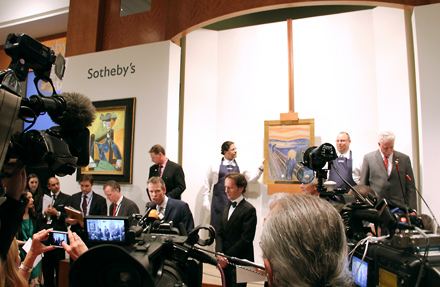
Sotheby’s Impressionist and Modern Art Auction
Auction Houses
Cold, corporate entities were the first to develop a larger bucket with which to catch this flow of money, with Christie’s baton-passing dream-team of Philippe Ségalot, Dominique Lévy, and Amy Cappellazzo at the lead. This group introduced the auction of emerging artists at the end of the ‘90s, refined the event-driven push to buy at auctions, further “curated” their sales to match public taste, multiplied the number of auctions and their formats (long gone is the time of May and November auctions), reinforced very effective marketing strategies to create hype even when the quality does not justify it, developed their massive informational advantage into more private sales, and Sotheby’s has gone so far as to move beyond auctions from the primary market with the opening of its S2 gallery space in New York (following in Christie’s footsteps).3
In line with online auction services like Paddle8, auction houses have developed a deadly weapon for attracting more sellers and even artists directly: online auctions where the results of individual sales are not made public. This is ideal if you do not want to “burn” unsold lots, or if you want to undermine and devalue fair prices through an opaque sales system. Transparency of auctions has previously created an understanding of the value of an artist’s work—removing this throttles the field.4 These corporations’ primary weaknesses are greed and poorly controlled costs, which pushes them to raise commissions to unbearable levels, which should in turn create necessary competition. But like past illegal cartel agreements illustrate, we are in a duopolistic system. The exclusive nature of the art market makes competition difficult and expensive.
It is essential to understand auction houses as the triggering and disrupting agents of change in the evolution of the art market. They are decisively grabbing more of the galleries’ turf, from the most valuable to the least, as well as within primary and secondary markets. This economy consists mostly of two behemoths. To illuminate the capability of their international sway relative to the small world of galleries, the publicly listed Sotheby’s has a market capitalization of $2.5 billion! Yes, $2,500,000,000! This should be enough to convince individual galleries that only through association and organized collaboration will they be able to protect their ground and future relevance.
A group of galleries, among them the most prominent and entrepreneurial, also perked up to this “wave of money” and decided to develop larger “buckets” (a term first introduced to me by Andrea Glimcher of Pace Gallery) to catch this new rain as well. They identified art fairs as a key weapon to compete on the field of event-driven buying started by auction houses. From there, along with other tactics, they adopted branding strategies similar to those of the luxury goods industry. It is not my intention to label these galleries as the “bad guys.” Indeed, they took advantage of a rare opportunity and did so in a brilliant, entrepreneurial way.
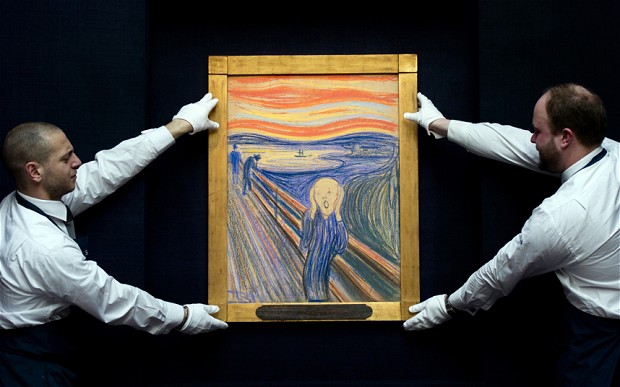
Sotheby’s auction of Edvard Munch’s The Scream sold for nearly $120 million in 2012.
Brutal Art, Brutal Investment
But it all came with the heavy burden of fixed costs that include staff (and particularly “qualified” sales staff and artist liaisons), real estate for multiple locations, art production, catalogue editing and production, and participation in exceptionally expensive art fairs around the world. The important consequence of this multitude of fixed-cost burdens on these mega-galleries (as I nickname them) is that they have no time to develop an artist anymore. Selling is the priority, and the organization is run completely along these lines. This has started another industry-changing trend: the “brutal” competition over very bankable artists (or VBAs, as I call them), as Pace’s Marc Glimcher intoned while simultaneously inaugurating the gallery’s London branch with a showing of Mark Rothko paintings and Hiroshi Sugimoto photographs.5 In addition, this whole system involving new and often “entrepreneurial” money that follows the rebranded, neo-luxurious mega-galleries and auction houses is also contributing to the art-flipping sales strategies instilled in the market, which by now has unfortunately spread its profiteering influence among the most seasoned collectors.
As Alexander Forbes discovered in his research for Artnet on art as investment, “In 2012, 53 percent of collectors took an investment view, to some extent, on their purchases. Just two years later, in the 2014 survey, that cohort has risen to 76 percent of overall respondents. An even greater 81 percent of arts professionals surveyed in 2014 suggested that their clients claim to take the possibility of a future return on investment into consideration when buying art. . . . Wealth managers appear to be most interested in art’s potential tax benefits for their clients, expressing the most interest in art philanthropy and estate planning services. That is an area which can, at times, benefit from the art market’s opacity. So, it will be interesting to watch where wealth managers’ interest shifts in the coming years as the structures that bolster that opacity continue to be broken down by innovation.”6
These market driven trends also bring about a pseudo art investment industry and the infamous “art funds.” For a comprehensive view, even if it is in need of refreshing, I highly recommend Art of the Deal: Contemporary Art in a Global Financial Market by Noah Horowitz. The art fund industry has suffered extinction twice already (in 2000 and in 2008) because it is based on a faulty business plan: buying works, valuing them optimistically as no valuations exist, selling the best performing pieces to boost performance, but then collapsing when the unsalable leftovers are liquidated. Mr. Horowitz underlines the inherent massive conflict of interest between the fund and its managers when acquiring “hot” artworks plus the “against-nature” character of the art fund industry in an art market where galleries try their best to avoid re-selling. How could you ever consider as an “asset” an instrument that needs to rise in price by at least 50 to 100% in order to recover transaction costs, without mentioning the total opacity of these complex transactions? The most intellectually insulting part is the insistence of professionals calculating performance comparisons complemented by senseless correlations and simply imaginary Sharpe ratios7 in their reports on “art as investment.”
Indeed, more top galleries have been extending their “hunt” for VBAs at the lower level. I only have to remind you of cases like Takashi Murakami moving from Marianne Boesky to Gagosian, or Ryan Trecartin from Elizabeth Dee to Andrea Rosen, or Adel Abdessemed from Kamel Mennour to David Zwirner, et cetera.
We would not care so much if this only concerned those few hundreds of individuals at the top of the market, but this drive for money rather than art—and I am not saying one has to exist without the other—is polluting, if not endangering, the whole ecosystem that supports the creation and distribution of art.
As the time for artists to make their place in the sun shortens due to the demands of the market, they are pushed to emphasize what sells, which is often not the most demanding or most interesting art. This quote by Alex Katz from New York Magazine summarizes the situation perfectly: “It’s hard for young artists. You’re an adult at 18, but for a painter it takes longer. You don’t really get it together until 35 or 45. In the 1950s, you had seven or eight years to experiment. But now you have to sell your first show and your second show and get a third show. And if you don’t, you’re a failure.” Then again, he says, “there are always people with new walls.”8
How are those tier-two galleries supposed to hold their ground at a table where the chip minimum is increasingly expensive and losing with their best-selling artists leaves them with no compensation? This all leave us schematically with three gallery tiers: the mega-galleries, the mid-size, and the emerging (with less than five years of existence). Only the top tier is thriving in the current circumstances. Emerging galleries do all right in their first years, but as soon as their artists mature they are faced with difficult choices leaving them to take a more business-like approach. Too many of them prefer to close, even if they reach the “nirvana” of LISTE Basel or FIAC, rather than compromise their vision. Examples are numerous around my country: Tulips and Roses, Hoet Bekaert, Vidal Cuglietta, Sebastien Ricou. The mid-size ones are crushed under higher and higher fixed costs and are often faced with the difficult “grow or go” dilemma, with some taking a shot at the top league (Sprüth Magers, Sean Kelly, Lehmann Maupin, Friedrich Petzel, and more), while others quit with interesting insights in their “lot” (d’Amelio Terras,Martin Klosterfelde, Nicole Klagsbrun, Jérôme de Noirmont, DCKT, Galerie Kamm, Giti Nourbakhsch).
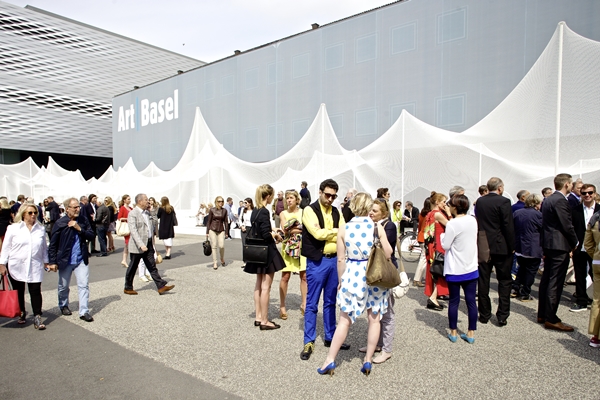
Art Basel
The Foundation, Structure, and Infrastructure of the Art Industry
Starting with the belief that the art market is now an “industry,” the path to its future is lain through reinforcing its foundation, structure, and infrastructure. The first and essential step at this point is to define at an industry level what best practices are as in any sustainable business. These best practices would be cast into model contracts, which would replace the dangerous handshake way of currently doing business. Those best practices and model contracts would be decided after swift discussions among visionary representatives of the art market’s stakeholders: artists, collectors, galleries within the three tiers, directors of institutions, and of course, a few lawyers. This implies the constitution of professional associations, starting with the three tiers of galleries, despite the fierce individualism of most gallerists. Otherwise, we will continue the broken status quo, deepening the fortunes of lawyers through case-by-case negotiations..
Don’t be scared. This is the normal development of an industry. Are you not using model contracts for buying a house, a car, a vacuum cleaner, or for hiring employees or buying insurance? What if nothing changed? It is a real possibility as conservatism is pervading the organization of the art world. This could be a vision of a dark future in which a winner-takes-all market thrives: dominating auction houses fighting with mega-galleries for VBAs who increasingly become represented by agents. Around them would arise “exhibiting” galleries without a deep involvement in the artist’s development.
I received an email from a keen and ideally positioned observer: Annette Schönholzer, who was, until last summer, Art Basel’s director of new initiatives. She wrote, “The situation across Southeast Asia and China is even more precarious, where the gallery system as we know it, and which still is widely taken for granted in the Western Hemisphere, is neither deeply rooted nor has established and reliable relationships and responsibilities between galleries, artists, collectors, auction houses, or art fairs.”
Let me list some relationships in urgent need of contracts through the proliferation of expensive litigations and abuses of power as these are the most convincing evidence that best practices and model contracts are essential at this point:
-Contracts drawn at the time of the purchase: Too many withdrawals from buyers and galleries occur. As well, consignment agreements protect accountability, as in the case of the lost Sol LeWitt wall-drawing certificate of Steinkamp vs. Rhona Hoffman.9
-Between galleries and artists: Is it acceptable that the gallery’s main asset can walk through the door at any time and without any compensation for the years if not decades of investment in its development? Soccer clubs have found a way to compensate for this training, and though I am far from comparing art galleries with soccer clubs, would it not be possible to find balanced arrangements that monetarily value this essential investment in the art world? New York legislature recently strengthened the provisions requiring galleries to separate and hold in trust the artwork and sales proceeds owed to consignors. Galleries that disregard these obligations may now be criminally sanctioned, and may have to pay attorney’s fees to artists in civil suits.10 Such rules do not exist outside of the U.S.A. and will be necessary as I have had to intervene more than once at artists’ request in similar conflicts.
-Between collectors and artists: It is known that artist Daniel Buren is refusing to issue certificates to collectors before an auction sale. In addition, see cases like Cady Noland vs. Marc Jancou, and Murakami vs. Boesky, regarding the misappropriated sales of artworks; or Kreuk vs. Danh Vō and Sobel vs. Eggleston, which dealt with the misunderstood conditions of artists’ deliverables.
-Between collectors and gallerists: See Perelman vs. Gagosian, Cowles vs. Gagosian, Hoffman vs. Levy, Jane Holzer vs. Stephan Stoyanov.
-Between collectors and artists advised by their galleries on reproducible media, such as photography, video, or digital art: There is absolutely no understanding by galleries and therefore by artists that the rights and duties of both parties should be clearly stated before buying reproducible media. Exhibitions? Preservation? Editions? The medium is completely stifled by this lack of structure and vision. In addition, see the case of Sobel vs. Eggleston.
-Between art advisors and collectors: See Maleki vs. Amir Shariat and Achenbach vs. Albrecht.
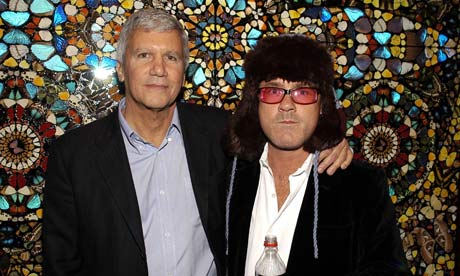
Larry Gagosian with Damien Hirst.
Toward a Resistant Ecosystem for Art
It is becoming difficult for challenging art to flourish in the current market. I remember conversations I had with serious and dedicated gallerists: Philippe Valentin of Chez Valentin in Paris and Anita Beckers of her eponymous gallery in Frankfurt. Both came to the same conclusion: “Programs are getting artistically better and better but we sell less and less.” It is indeed becoming more difficult to support oneself while presenting challenging artwork outside of popular sales trends. How can the “little” stand in the face of true “war machines”?
Then one night I watched a documentary about the French resistance during WWII. I was impressed by the way people from totally different backgrounds and beliefs—communists, Catholics, nationalists, bourgeoisie, proletariat, nobles—put aside their differences in order to achieve one goal. I am very far from comparing auction houses, mega-galleries, and their clients to the Axis powers, but I was impressed by what the concentration of “little” forces could achieve, even when confronted with overwhelming power. And I believe now that this collaboration across the fence is the solution to let “different” art blossom under the shadow of the larger and still growing art market tree. In times of change and crisis, you need to construct outside of the usual way of thinking.
Building the Resistance through Alternative Models
The professionalization of the gallery system is the necessary first step. I find that galleries rarely have a legitimate business plan, but rather a short road map that consists mainly of participation in art fairs if they are achievable. So much focus is on the art fairs they love to hate that they forget about necessary improvements in their operation. Gallerists need to decide what to do with their spaces as so many complain that the number of visitors is decreasing dramatically. One option is to spend more time and energy “animating” the space, shaping it into a forum where visitors, collectors, experts, and artists can meet, exchange, learn, and eventually buy. As well, these spaces could serve as conduits for artists and other experts to engage with the public, rather than keeping them behind closed doors. I like the model of thepublicschool.org, which is a “framework that supports autodidactic activities, operating under the assumption that everything is everything,”11 and functions as a network to connect people who want to teach with people who want to learn.
Gallerists should also take the time to thoroughly understand emerging and longstanding collectors who are close to or interested in the gallery every chance they get. The art world can feel like an inaccessible entity that hides behind a bristly wall, and attempts to reach out to those who are interested need to be made. Too often I meet with gallerists who have not even taken the pain to Google me in order to save their time and mine. When collectors open their houses or private collections to new viewers I hear so often that the previous night was unfortunately too long . . . Is this a service industry or not?
Another facet where galleries are lagging in the wider economy is their inability to adopt technology that would improve their operational efficiency. How rare(but how simple of a task) is it still to find a PDF of catalogs on a gallery’s website, to record and distribute talks online with artists or experts, to develop online sales, to communicate via Twitter or Instagram or any other social media platform? Online sales are still in their infancy, but if they can increase sales by 10-15% a year without expensive efforts and with new clients, why neglect the possibility? Galleries are doing very little to take advantage of myriad resources, an absolutely basic step that every new business takes. In my travels, I am still surprised to find gallery personnel who hardly speak the art world’s lingua franca, English. This is a must. While galleries complain about the lack of visitors, they adopt opening hours that do not take into account the schedules of their potential clientele. It is coming to the point where only the unemployed or those who work outside of the standard workweek can visit them. Is this the objective?
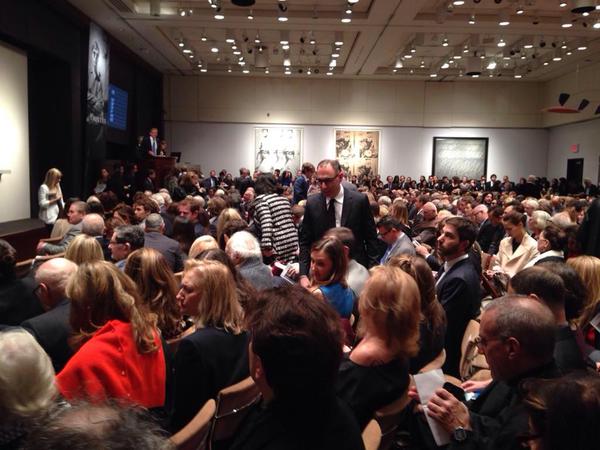
Jerry Saltz posted on his Instagram (@jerrysaltz) this photo of Christie’s November auction with the caption, “Oh good. Over 750 white collectors at Christies.”
Cooperation, not Separation
Cooperation between galleries and artists is the first and most essential relationship. It is only through this bond that developing artists can hope to establish and grow, which should be the central purpose of the gallery. I often (though not always!) feel a growing distance between galleries and their artists. Both parties are responsible: Artists often do not want to commit to more than one or at most a few shows, expecting that they will be discovered and swept up by a mega-gallery, and consequentially galleries do not want to invest too much in an artist who could leave them at any moment, despite vows of “eternal love.” This is a lose-lose relationship built upon the false hopes of both parties. As described earlier, a balanced, industry-wide model contract should be implemented as currently, without such, artists most often refuse to sign any contract, as they do not feel able to judge its fairness. Exceptions made through addenda to these model contracts, as with any binding document, would be possible through individual negotiations.
Galleries must build close cooperation between each other, as well. Gallerists, particularly those of the old school, are fierce individualists. Because of this, cooperation, particularly between old and new organizations, is sometimes very difficult. A tight collaboration and the compromises necessary to reach it are now necessary if they want to resist the overwhelming power of auction houses, mega-galleries, and art fairs. Unfortunately, old-school gallerists still primarily hold the reins in selection committees for clusters like Arte Madrid, or Neca in Bruxelles, or in too many art fair selection committees.
Public authorities must also contribute more substantially to galleries and other venues supporting the arts. This does not always have to come in the form of subsidies. Latitude, an arts-funding organization in Brazil, offers extensive support to galleries in the interest of attracting collectors and curators to the country, or to help them disseminate their projects abroad. Latitude also helps with transportation, professional training, and the consolidation of other logistical tasks.12
Organizations such as KunstKoop in Holland, and a recent initiative by 10 Group in Sydney, Australia, are supporting the purchase of contemporary art by offering standardized and cheap or interest-free loans for this purpose.13 These groups function either through governmental funding or through a combination of governmental seed money and private philanthropy that carries the loaning system into perpetuity. In Belgium, the BAM Institute for Visual, Audiovisual, and Media Art is organizing visits by international artists and makers multiple times a year to offer insight into the Belgian art scene. I am also appreciative of effective global collaboration through the exchange of space between like-minded galleries, such as Galerie Jocelyn Wolff in Paris and Labor in Mexico City, or between cities as with Brussels Cologne Contemporaries.
Collectors also have responsibilities that they must uphold between galleries and artists, and it would be unrealistic for me to present them all as saints. The capacity to aid in the production of artworks is one of the key competitive advantages of wealthier galleries. Collectors and galleries should collaborate in a mutual, profitable relationship for producing specific works. A few years ago, Emmanuel Perrotin, owner of Galerie Perrotin, had the foresight to create a “production” company. I don’t know why the initiative was later abandoned, but in my opinion this kind of business has a future, particularly in helping smaller galleries support their best artists.
All of this collectors’ support is essential for the future “marketability” of the artist, as often collectors check the usual price databases. Many gallerists shrug at auction prices, pretending that auction houses are not the same industry, but it is an insane mistake or sheer blindness that leads to this decision as buying from galleries or at auction is taking two parallel paths to the same art for a collector. Proactive galleries have adopted one potential solution: To inform an interested collector that the work of an artist is coming up at auction, describing its context and its retail value. If only one collector competes with other bidders, it can bring the price to a manageable level, which is a win-win situation for the collector, the gallery, and the artist. I recently received an email from a gallery I have a relationship with that exemplifies this approach:
“Dear Alain,
I hope you are well. Remembering your interest in Elliott Hundley, and in case you were not already aware, there is a special free-standing bulletin board and collaged screen that is coming up tomorrow morning at Christie’s. The estimated is 50,000 to 70,000 GBP ($79,300–$110,200). Generally speaking, we would estimate the price should be more in line with the low end of this estimate. We were happy to learn that the reserve has been lowered to be more in line with current retail prices for Elliott’s sculptures, and therefore an opportunity to acquire an early significant sculpture. It clearly stands out as a fantastic heavily worked sculpture, with all of the meticulous layering and detail that is so signature of his practice. We’re always happy to let you know about this kind of opportunity, and certainly want you to have our opinion and advice about the price.”
Lastly, it is the responsibility of collectors who complain about the standardization of “fair art” to make the effort to visit, promote, and support galleries outside of the mainstream.
The Future Economy of Art
The art market is at a historical turning point. Many paths are open to its future. I am hoping that galleries and other stakeholders will realize the necessity of making radical changes even if it means giving up some part of their “traditional” influence. I share my final thoughts with those put forth in a recent post by Edward Winkleman: “[V]arious members of the current community, who might see the advance of one or more components of an entire ecosystem as a threat to the control they currently enjoy over a segment of the scene . . . would be wise to embrace the entire ecosystem model, even should it temporarily inconvenience some of the currently long-suffering players. . . . In the end, everyone benefits [more] from there being a much bigger pie than they do by foolishly or fiercely protecting their little slice of the current, smaller pie. It’s not always easy to see things from that point of view, but it’s clear when folks act in ways that don’t recognize it, they’re generally doing so quite selfishly. Which is understandable, but not productive in the end.”14
Without changes along the lines described above, the existing gallery ecosystem is at risk of collapsing.
____
1) http://articles.latimes.com/2012/may/10/entertainment/la-et-cm-knight-art-money-20120510
2)http://www.theguardian.com/commentisfree/2011/dec/02/saatchi-hideousness-art-world
3)http://www.blouinartinfo.com/news/story/38598/sothebys-expands-beyond-the-auction-floor-with-its-new-s2-art-gallery/
4)http://www.bloomberg.com/news/2014-08-01/unsold-warhol-nickel-vanishes-in-opaque-online-auction.html
5)http://www.blouinartinfo.com/news/story/811795/its-become-extremely-brutal-paces-marc-glimcher-on-whats
6)http://news.artnet.com/market/what-is-behind-the-art-investment-boom-113619
7) A ratio developed by Nobel laureate William F. Sharpe to measure risk-adjusted performance. The Sharpe ratio is calculated by subtracting the risk-free rate—such as that of the 10-year U.S. Treasury bond—from the rate of return for a portfolio and dividing the result by the standard deviation of the portfolio returns.
8) http://nymag.com/arts/art/rules/alex-katz-2012-4/
9)http://www.courthousenews.com/2012/05/25/46826.htm
10)http://fkks.com/news/new-york-strengthens-law-governing-consignments-from-artists-to-galleries
11) http://thepublicschool.org/#
12) http://www.latitudebrasil.org/
13)http://m.smh.com.au/entertainment/art-and-design/interestfree-loans-for-contemporary-art-on-the-table-at-city-of-sydney-20140914-10gpe6.html
14) http://www.edwardwinkleman.com/2014/10/it-takes-ecosystem.html
